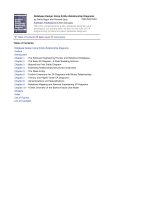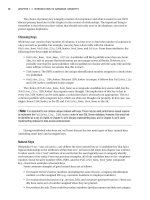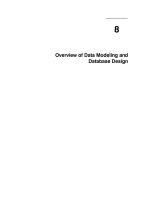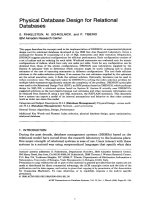Assignment1 Database Design Development(1622)
Bạn đang xem bản rút gọn của tài liệu. Xem và tải ngay bản đầy đủ của tài liệu tại đây (418.42 KB, 20 trang )
Higher Nationals in Computing
DATABASE DESIGN AND
DEVELOPMENT
ASSIGNMENT
No.1
Learner’s name: VO NGUYEN DUY NAM
Assessor name: NGUYEN VAN SON
Class: GCS1001B
Learner’s ID: GCS200888
Subject’s ID: 1622
1|Page
Assignment due:19/2/2022
Assignment submitted:
ASSIGNMENT 1 FRONT SHEET
Qualification
BTEC Level 5 HND Diploma in Computing
Unit number and
title
Unit 04: Database Design & Development
Submission date
Date Received 1st
submission
Re-submission Date
Date Received 2nd
submission
Student Name
VO NGUYEN DUY NAM
Student ID
Class
1001B
Assessor name
GCS200888
Student declaration
I certify that the assignment submission is entirely my own work and I fully understand the
consequences of plagiarism. I understand that making a false declaration is a form of malpractice.
Student’s signature
Grading grid
P1
M1
D1
Summative Feedback:
Grade:
Lecturer Signature:
Resubmission Feedback:\
Assessor Signature:
Date:
3|Page
ASSIGNMENT 1 BRIEF
Qualification
BTEC Level 5 HND Diploma in Computing
Unit number
Unit 04: Database Design & Development
Assignment title
Academic Year
Unit Tutor
Issue date
Submission date
IV name and date
Submission Format:
Format:
This assignment is an Individual assignment and specifically including 1 document:
You must use font Calibri size 12, set number of the pages and use multiple line spacing at
1.3. Margins must be: left: 1.25 cm; right: 1 cm; top: 1 cm and bottom: 1 cm. The reference
follows Harvard referencing system. The recommended word limit is 2.000-2.500 words. You
will not be penalized for exceeding the total word limit. The cover page of the report has to
be the Assignment front sheet 1.
Submission Students are compulsory to submit the assignment in due date and in a way requested by the
Tutors. The form of submission will be a soft copy posted on />Note:
The Assignment must be your own work, and not copied by or from another student or from
books etc. If you use ideas, quotes or data (such as diagrams) from books, journals or other sources, you
must reference your sources, using the Harvard style. Make sure that you know how to reference
properly, and that understand the guidelines on plagiarism. If you do not, you definitely get fail
Unit Learning Outcomes:
LO1 Use an appropriate design tool to design a relational database system for a substantial problem.
LO2 Develop a fully functional relational database system, based on an existing system design.
4|Page
LO3 Test the system against user and system requirements.
LO4 Produce technical and user documentation
Assignment Brief and Guidance:
You are employed as a Database Developer for a large IT consultancy company. The company has been
approached by FPT university which is expanding due to the growth of the number of students. FPT is
currently facing difficulties in dealing with managing the university. It decided to develop several
academic systems to manage the university easier including: Online Library system, Student Grading
System, Attendance System, CMS System, Scheduling System, Enrolment Systems, and so on.
You are tasked to select one of those systems to develop database for FPT university. Your tasks are to:
Work with FPT to find out about current requirements for each system
Analyze the requirements and produce clear statements of user and system requirements.
Design a relational database system using appropriate design tools and techniques Develop
a fully functional relational database system, based on an existing system design.
Test the system against user and system requirements.
Produce technical and user documentation
Part 1 (Assignment 1)
Before you start the development process, your manager has asked you to produce a report for the CEO
of FPT, containing:
1. Clear statements of user and system requirements. The system must have at least 2 user roles, including
business processes and statistical reports for FPT university managers.
2. The design of the relational database system using appropriate design tools and techniques. It should
contain at least four interrelated tables.
You would prefer to produce a more detailed document, so you will produce a comprehensive design for a
fully functional system which will include interface and output designs, data validations and cover data
normalization.
Your manager would like on the report your assessment of the effectiveness of the design in relation to
user and system requirements.
Part 2 (Assignment 2)
Once the designs have been accepted by your manager you have been asked to:
1.3. Develop the database system using evidence of user interface, output and data validations
and querying across multiple tables.
5|Page
You want to include more than just the basics so you will implement a fully functional database system
which will include system security and database maintenance features.
2. You have decided to implement a query language into the relational database system. The developed
system will be demonstrated to your manager in the report including:
•
Assessing whether meaningful data has been extracted through the use of query tools to produce
appropriate management information.
•
Evaluating the effectiveness of the database solution in relation to user and system requirements,
and suggest improvements.
3. Once the system has been developed, you will test the system and your manager will complete a witness
statement indicating how your tests are performing against user and system requirements.
Besides, you will produce a brief report assessing the effectiveness of the testing, including an explanation
of the choice of test data used.
4. Lastly you will produce technical and user documentation which will be given to the company.
You want to provide some graphical representations for ease of reference in the technical guide, so you
have decided to produce a technical and user documentation for a fully functional system, including
diagrams showing movement of data through the system, and flowcharts describing how the system
works.
Learning Outcomes and Assessment Criteria
Pass
Merit
Distinction
LO1 Use an appropriate design tool to design a relational database system for a substantial problem
P1 Design a relational database
system using appropriate design
tools and techniques, containing at
least four interrelated tables, with
clear statements of user and system
requirements.
M1 Produce a comprehensive design
for a fully functional system which
includes interface and output designs,
data validations and data
normalisation.
D1 Assess the effectiveness of the design
in relation to user and system
requirements.
6|Page
ASSIGNMENT ANSWER
I.
DATABASE DESIGN (P1)
1. Scenario of the chosen system
After the cooperation of FPT university and NVIDIA Inc, it is essential for me to
design database for FPT university’s education system. FPT is concerned about the
growth of the number of students in a few next semesters. As I observe opinions
and complaints from most students from FPT university, most of them mention
about the traditional library. Due to the increase in students, The traditional
system can’t meet student needs . Here are some reasons about it:
+ Because of the pandemic, many students aren’t be able to borrow books or get
its information on the spot
+ With more and more students borrow books which lead to information overload
to the library, incorrect information like wrong borrow date, extraordinary
expenses, …. Usually appear
+ Traditional library with outdated methods
So I decide to develop an efficient fully functional database system for FPT
university which I call
Online Library system with specific IDs and many features . Online Library
system will replace the traditional library in the upcoming future
I will explain this system thoroughly in the remain pages
2. SRS (System Requirement Specification)
3. Logical design (ERD)
4. Explanation
Explain briefly about ERD (entities, their relationship). Give reasons why ERD is
suitable for the system
5. Physical design
II. DATA VALIDATION AND NORMALIZATION (M1)
1. User Interfaces of your system
2. Data Validation (included in physical design)
7|Page
3. Normalization:
Explain why each of the table is 3rd Normal Form, if not, explain why.
III. DESIGN EVALUATION (D1)
-Explain in details and with critical review, how your ERD design (entities,
relationships) can meets the user and system requirements.
Scenario
After the cooperation of FPT university and NVIDIA Inc, it is essential for me to
design database for FPT university’s education system. FPT is concerned about
the growth of the number of students in a few next semesters. As I observe
opinions and complaints from most students from FPT university, most of them
mention about the traditional library. Due to the increase in students, The
traditional system can’t meet student needs . Here are some reasons about it:
+ Because of the pandemic, many students aren’t be able to borrow books or get
its information on the spot
+ With more and more students borrow books which lead to information overload
to the library, incorrect information like wrong borrow date, extraordinary
expenses, …. Usually appear
+ Traditional library with outdated methods
So I decide to develop an efficient fully functional database system for FPT
university which I call Online Library system with specific IDs and many
features . Online Library system will replace the traditional library in the
upcoming future
I will explain this system thoroughly in the remain pages
8|Page
TABLE OF CONTENTS
I. DATABASE DESIGN
1. SRS (System Requirement Specification)...........................................................
11-12
2. Logical design
(ERD)........................................................................................... 13-15
2.1. What is logical design
(ERD)......................................................................... 13
2.2.
Entities........................................................................................................... 13
2.3. Types of
entities............................................................................................ 13-15
3.
Attribute..............................................................................................................
15
3.1Type of
attributes............................................................................................ 15
4. Entity
relationship................................................................................................ 15
5. Types of
relationships......................................................................................... 15-16
6. Online library system logical design
(ERD)......................................................... 17
7. Why erd suitable for this
system......................................................................... 17-18
8. Physical
Design................................................................................................... 18
REFERENCES……………………………………………………………………………
…………………………19
9|Page
ASSIGNMENT 1
I. DATABASE DESIGN
1. SRS (System Requirement Specification)
- A System Requirements Specification (SRS) (also known as a Software
Requirements Specification) is a document or set of documentation that
describes the features and behavior of a system or software application.
Figure 1. Online library system (KUMAR, 2019)
-
The Online Library System is intended to automate the library activities such
as creating a new borrower, giving books to the borrowers, maintaining the
details of all the item that were available in the books . This also helps the
librarians by providing information such as borrow date, book titles, ….
-
System requirements:
+ Students are allowed to log in to the online library system with student ID
+ Database of student information storage systems such as student names, student
phone numbers, gmail students
+ The system helps manuals to create, update and exploit information easier. Data
will be updated regularly and will not be copied. Using databases to help store them
and easily manage them.
+ The system allows students to check the information of the book they borrowed,
the loan date, return date and buy rental books
+ The system needs to ensure that no two students have the same ID and librarian
and books
+ After the student logs in and searches for boolid, baborid, libraryid. The system
will be able to display all the information at the same time
+ The system can demonstrate all tables at the same time
10 | P a g e
+ Detecting system when students enter wrong
data types - Usecase Diagram:
Figure 2. Usecase Diagram
11 | P a g e
2.Logical design (ERD)
2.1. What is logical design (ERD)
Figure 3. Example of logical design
Logical design is the
second stage in the
database design
process. The logical
design goal is to
design an
enterprise-wide
database based on
a specific data
model but
independent of
physical-level
details. Logical
design requires that
all objects in the
conceptual model
be mapped to the specific constructs used by the selected database model
-
2.2. Entities
-
An entity is an object that exists. It doesn’t
have to do anything; it just has to exist. In
database administration, an entity can be a
single thing, person, place, or object. Data
can be stored about such entities. A design
tool that allows database administrators to
view the relationships between several
entities is called the entity
relationship diagram (ERD)
Figure
4.Entities example
- In the Figure 3, we can see that Employee, Health Plan enrolment
are entities
2.3. Types of entities
-
According to expertise knowledge, There are 4 types of
entities:
+ Domain entities
12 | P a g e
-
Entities represent domain objects and are primarily defined by their
identity, continuity, and persistence over time, and not only by the
attributes that comprise them. An object primarily defined by its identity is
called an Entity. Entities are very important in the domain
model, since they are the base for a model
-
Now look at the figure 2, There are some domain entities such as users,
coach, habits,…
+ Linking entities
Figure 5. Linking entities example
-
Linking entities sometime use to solve m-n relationship in database
As you can see from figure 4, Linking entity is Primary Key Which
involve to 2 other Primary Keys : Student ID and Subject ID
+ Lookup entities
-
Lookup entities are essentially utility entities
13 | P a g e
Figure 6.Lookup entity example
-
In this case, CarMake and CarModel describe a single entity set each.
Their functional dependencies are CarMakeId -> CarMakeName and
CarModelId -> CarModelName
+ Weak entities
-
-
In a relational database, a weak entity is an entity that cannot be
uniquely identified by its attributes alone; therefore, it must use a
foreign key in conjunction with its attributes to create a primary key. It
dependent on other entities for its meaning
Grade is a weak entity in figure 4 because Student ID and Subject ID
define its meaning.
3. Attribute
Figure 7.Table Habits
-
-
In relational databases, attributes are the describing
characteristics or properties that define all items
pertaining to a certain category applied to all cells of
a column. The rows, instead, are called tuples, and
represent data sets applied to a single entity to
uniquely identify each item. Attributes are, therefore,
the characteristics of every individual tuple that help describe its unique
properties.
Attribute in table Comments (Figure 6) is HabitName.
3.1.
Type of attributes
•
Composite attribute: is an attribute composed of several other simple
attributes. For example, the Address attribute of an Employee entity could
consist of the Street, City, Postal code and Country attributes.
•
Multivalued attribute: is an attribute where more than one description can
be provided. For example, an Employee entity may have more than one Email
ID attributes in the same cell.
•
Key attribute or primary attribute: is an ID, key, letter or number that
uniquely identifies that item. For example, it can be the number of a certain
invoice (e.g. the individual ID of that invoice). A table that contains a single key
attribute is considered a strong entity. However, a table might contain more
than one key attribute if it’s derived from other tables.
•
Derived attribute: as the name implies, these are derived from other
attributes, either directly or through specific formula results. For example, the
Age attribute of an
14 | P a g e
Employee could be derived from the Date of Birth attribute. In other instances,
a formula might calculate the VAT of a certain payment, so that whenever the
cell with the attribute Payment is filled, the cell with the derived attribute VAT
automatically calculates its value.
4. Entity Relationship
-
The process of logical design involves arranging data into a series of logical
relationships called entities and attributes. An entity represents a chunk of
information. In relational databases, an entity often maps to a table. An
attribute is a component of an entity and helps define the uniqueness of the
entity.
5. Types Of Relationships
-
This include 3 types of relationships
+ One to one relationship:
-
Each row in the primary entity, there can be no more than 1 related row in the
secondary entity
-
One to one relationship crow’s foot
Figure 8. One or none
Figure 9.
Only one
+ One to many relationship:
-
Each record in the primary entity there can be many associated records in the
secondary entity
-
One to many relationship crow’s foot
Figure 10. None or more
Figure 11. One or More
+ Many to many relationship:
15 | P a g e
-
Each record in a primary entity can have many related records in a
secondary entity
Each record in the secondary entity can have many related records in
the primary entity
Many to many relationship Crow’s foot
Figure 12. Many to many
6. Online Library System Logical Design (Erd) Here Is The
Logical Design For The System:
-
Use Draw.io to create ERD
-
So I will list all tables of the system:
+ My system include 5 tables: Student, Borrow, Book, Librarian and
BorrowDetail
+ Every student has an unique number Which is called Student ID so as Book,
Author and Borrow
+ Table Student display Student ID, Student’s Name, Student Gmail, Student
Phone
Number
+Table Book include Book ID, Book title, BookAuthor, BookPublisher
+Table Librarian include Librarian ID, Full Name, Gmail and Phone Number
+Table Borrow Books include Borrow ID, Student ID, Librarian ID, Borrow
Date , Return Date
+Table BorrowDetail include BorrowID, BookID, quantity and Book rental cost
16 | P a g e
Figure 13. Online library system logical design (ERD)
7. Why Erd Suitable For This System:
+ An entity-relationship diagram, or ER diagram, is essential for modeling the data
stored in a database. It is the basic design upon which a database is built. ER
diagrams specify what data we will store: the entities and their attributes. They also
show how entities relate to other entities.
+ Visual representation: it makes database easier to design and being able to identify
the flow of data and the operation of the entire system is made
+ Effective communication: Because of using given symbols to represent different
types of information. This symbol allow designer to understand database properly
+ Easy to understand: Designer can easily design entity relationship diagram so all
individuals can also understand them.
8. Physical Design
-
Physical database design
Table: Student
Field name
Data
Allow
type
nulls
studentID
Nvarchar(1
No
0)
studentFullName Nvarchar(3
No
0)
studentGmail
Nvarchar(4
Yes
0)
studentPhoneNu Nvarchar(1
Yes
mber
0)
Table: Librarian
Field name
Data
Allow
type
nulls
librarianID
Nvarchar(1
No
0)
Description
Primary Key
Name of the student
Student Gmail
Student Phone Number
Description
Primary Key
17 | P a g e
librarianName
Nvarchar(2
0)
librarianGmail
Nvarchar(3
0)
librarianPhoneNu Nvarchar(
mber
20)
Table: Borrow
Field name
Data
type
borrowID
Nvarchar(1
0)
studentID
Nvarchar(1
0)
librarianID
Nvarchar(1
0)
borrowDate
Date
returnDate
Date
Table: Book
Field name
Data
type
bookID
Nvarchar(1
0)
bookTitle
Nvarchar(3
0)
bookCategory
Nvarchar(2
0)
bookPublisher
Nvarchar(2
0)
Table: BorrowDetail
Field name
Data
type
bookID
Nvarchar(1
0)
borrowID
Nvarchar(1
0)
quantity
int
BookRentalCost Int
No
Name of the librarian
Yes
Librarian Gmail
Yes
Librarian Phone Number
Allow
nulls
No
Description
Primary Key
No
Foreign Key
No
Foreign Key
Yes
Yes
Book borrow date
Book return date
Allow
nulls
No
Description
Primary Key
Yes
Bok title
Yes
Book category
Yes
Book Pubisher
Allow
nulls
No
No
Yes
Yes
Description
Primary key, Foreign key
Primary key, Foreign key
amount of borrow books
Book Rental Cost
18 | P a g e
REFERENCES
- FERGUSSON, K., 2018. DRAW.IO. [ONLINE] :
/>- GIBBS, M., 2022. STUDY.COM. [ONLINE] :
/>%20that%20exists.&text=In%20database%20administration
- INFLECTRA, 2022. INFLECTRA. [ONLINE]:
/>- TEAM, V., 2021. VERTABELO. [ONLINE]:
/>- TOBY J. TEOREY, SAM S. LIGHTSTONE, TOM NADEAU, H.V. JAGADISH, 2011.
DATABASE MODELING AND DESIGN. IN: R. ADAMS, ED. S.L.:MORGAN
KAUFMANN, P. 301. UNKNOWN, 2020. TECHOPEDIA. [ONLINE] :
/>
- VEFTHYM, 2016. STACKOVERFLOW. [ONLINE] :
/>
19 | P a g e









